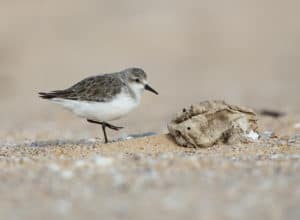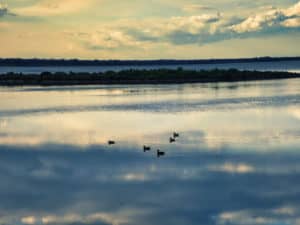Good news. Victoria’s environment department is looking to better protect our Ramsar wetlands.
A Ramsar wetland is a rare and unique wetland with special protections.
Victoria’s Ramsar wetlands are home to waders and waterbirds like the Pacific Golden Plover, Eastern Curlew, and Fairy Tern. Migratory shorebirds visit Victoria to feed in the mudflats in coastal and inland wetlands.
But many of our wetlands have been degraded, so it’s especially important we look after the ones we have.
That’s why we’re so pleased the state government is reviewing protection for wetlands. Help make the most of this rare chance to give these wetlands international and national recognition.
The survey has now closed
Some key messaging for the Wetlands around Geelong (Point Wilson, Avalon Coastal, Moolap Point Henry) survey:
- We recommend the Ramsar boundary be reviewed to include all of Point Henry, including the Point Henry Foreshore Reserve
-
Caption: Red-necked Stint, Dan Weller
- This area is known as an Important Bird Area (IBA), the intertidal mudflats support nationally significant Australian populations of the Pacific golden plover, Red-necked Stint, Curlew Sandpiper, and the Banded Stilt
- We recommend the boundary of this entire area be extended seaward to include the intertidal areas and the seagrass meadows that the important bird populations rely on. This ensures the boundary is consistent with other proposed areas within the Port Phillip (Western Shoreline) and Bellarine Ramsar site, such as at Point Wilson
- We support the extension and joining of the Corio Bay and Werribee River Ramsar areas
- We find it problematic that a strip of land owned by the department of defence has been omitted, and suggests one continuous Ramsar area
- The area is important for many migratory bird species of state and national significance, such as the Curlew Sandpiper and Orange-bellied Parrots
Wetlands on the coast Southeast of Geelong Survey
Some key messaging for the Wetlands on the coast southeast of Geelong (Lake Conneware, Breamlea Karaaf) survey:
- We support the proposed extension of Lake Conneware
- Lake Conneware has one of the most diverse saltmarsh areas in Australia and is of national significance. Several vegetation communities exist here which are rare elsewhere in Victoria, including Silky Wilsonian herbland, Australian Salt-Grass grassland. Fauna at this Ramsar site is of international significance and important for waders, waterbirds, and the wintering of the orange-bellied parrot
- We support the proposed extension of Breamlea Karaaf
- The wetlands area is important for Orange-bellied Parrot, they contain both wet and dry saltmarsh and adjoin Poa grasslands and dunes with coastal Moonah
Wetlands on the Bellarine Survey
Some key messaging for the Wetlands on the Bellarine (Lonsdale Lakes/Lake Victoria, St Leonards/Salt Lagoon, Edwards Point/Sand and Swan Islands) survey:
- We support the new areas proposed
Caption: Swan Bay, Alan Travers
- The area is important for Coastal Saltmarsh/Mangrove Shrubland Mosaic, Grassy Woodland, Wetland Formation and Plains Grassland
- We support the proposed addition of St Leonards Salt Lake into the Ramsar site but advocate for the north section of the lake to be included too, as currently, it leaves out a significant area of the lake
- The Lakes’s dry saltmarsh is of particular significance
- We support the proposed extensions at Edwards Point/Sand and Swan islands
- Swan Bay is significant both at the state and international level, it is important for wet and dry saltmarsh and dune scrub, waders and waterbirds such as the Pacific Golden Plover, Grey Plover, Eastern Curlew, and Fairy Terns. This site supports more than one percent of the world’s population of the Blue-billed Duck, Chestnut Teal, Australian White Ibis, Red-necked Stint, and the Silver Gull
Wetlands of the Northern Bay Survey
Some key messaging for the Wetlands of the Northern Bay (Jawbone Altona, Cheetham Wetlands, Grahams Reserve) survey:
- We support the addition of the Cheetham wetlands into the Ramsar site, however, recommend the boundary extend further seaward to account for tidal influences. This ensures the boundary is consistent with other proposed areas in this Ramsar site.
- The animals that use these areas are nationally and internationally significant, including the Orange-bellied Parrot, Striped Legless Lizard, and the Yellow Sedge-skipper Butterfly.
- This area is one of few that support more than one percent of the world’s population of the Red-necked Stint, Chestnut Teal, and Pacific Gull.
Wetlands are really important parts of our living world, linking land and water.
They protect our shores, reduce and control floods, absorb pollutants and improve our water. Full of all kinds of life, they’re habitats for native animals and plants.
Thank you for using your voice to speak out for these special landscapes.
Next steps
Submissions will be reviewed over the coming months, with the final list of areas and approvals to be released by summer.

